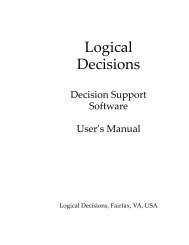AFTER VIOLENCE: 3R, RECONSTRUCTION, RECONCILIATION ...
AFTER VIOLENCE: 3R, RECONSTRUCTION, RECONCILIATION ...
AFTER VIOLENCE: 3R, RECONSTRUCTION, RECONCILIATION ...
You also want an ePaper? Increase the reach of your titles
YUMPU automatically turns print PDFs into web optimized ePapers that Google loves.
level of participation, a rich, blooming civil society with<br />
bridges across conflict divides, elites who see conflict as raw<br />
material to be processed into higher levels of peacefulness, and<br />
by peaceful means. Violence is not in the culture; peace is.<br />
Negate all of this and we get conflicts monopolized by elites<br />
who use violence to "settle" the conflict and to secure their own<br />
position, and people standing by, watching, waiting, accepting the<br />
monopoly of national elites and of the world elites in the<br />
"international community". Violence is in the culture, because<br />
"it is in human nature; such is life."<br />
So Phase I slides into Phase II, violence occurs, with all,<br />
most or many of the effects to be pointed out in Table 3.1. There<br />
is a cease-fire, and Phase II becomes Phase III. What do we do?<br />
Learn from people: they do the same as ants when their hive is<br />
destroyed: they start reconstruction (chapter 7 below). But of<br />
human beings we should expect more. Whether the war was<br />
"internal" or "external" there is the necessity of some kind of<br />
reconciliation (chapter 8 below). People cannot live apart and in<br />
agony forever. And: there is the need to do in Phase III what was<br />
not done in Phase I, resolution (chapter 9 below). If not, Phase<br />
III becomes the new Phase I, reproducing the tragedy.<br />
3. Mapping the Violence Formation<br />
Our first point of departure was an impressionistic listing of the<br />
violence aftermath. The second point of departure was the vicious<br />
cycle in a violence triangle of direct, structural and cultural<br />
violence. In a third effort we shall now bring this together in a<br />
more complete map, covering six "spaces", and both<br />
material/visible and nonmaterial/invisible effects:<br />
Table 3.1: Visible and invisible effects of direct violence<br />
---------------------------------------------------------<br />
SPACE Material, Nonmaterial,<br />
15
















